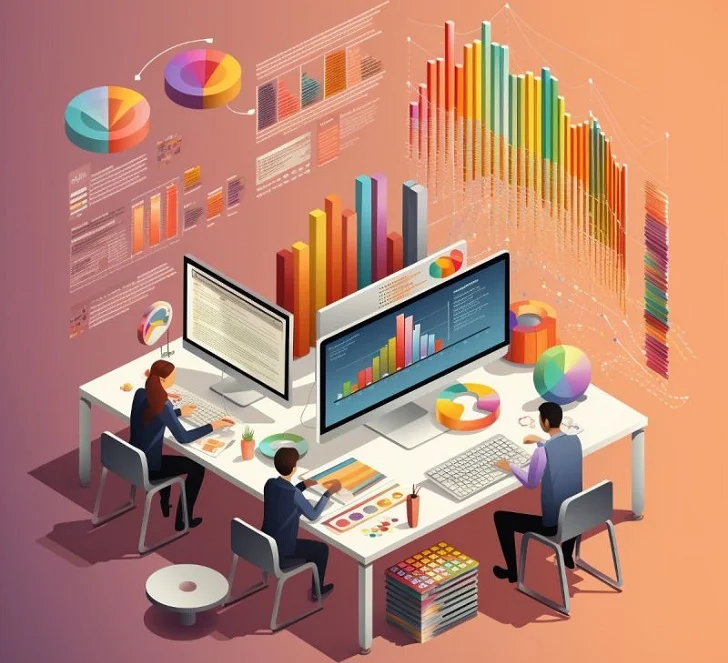In today's data-driven world, organizations have a wealth of
information at their fingertips. However, the true power of this data lies in
the ability to analyze it effectively and derive actionable insights. Whether
you're a business professional, a data enthusiast, or someone curious about
data analysis, this guide will walk you through the essential steps, tools, and
techniques needed to turn raw data into meaningful insights.
1. Define Objectives
The first step in any data analysis project is to define clear
objectives. What are the questions you want to answer? What goals do you aim to
achieve? Without clear objectives, it's easy to get lost in the sea of data.
For instance, a retail company might aim to identify key factors influencing
sales and forecast future revenue.
2. Data Collection
Once the objectives are set, the next step is to gather data
from relevant sources. This could involve extracting data from databases,
conducting surveys, pulling data from sensors, or collecting logs. Ensuring the
data is comprehensive and relevant to your objectives is crucial.
3. Data Cleaning
Raw data is often messy. It may contain missing values,
duplicates, or errors. Data cleaning involves handling these issues to prepare
the data for analysis. This step ensures the accuracy and reliability of your
analysis. Techniques include filling in missing values, removing duplicates,
and correcting data entry errors.
4. Exploratory Data Analysis (EDA)
Exploratory Data Analysis (EDA) is about getting to know
your data. It involves using statistical summaries and visualizations to
understand the main characteristics of the data. Key EDA techniques include:
- Summary
Statistics: Calculating mean, median, mode, standard deviation, etc.
- Data
Visualization: Creating histograms, scatter plots, box plots, and more
to visualize data distributions and relationships.
- Pattern
Identification: Looking for trends, patterns, and anomalies that might
warrant further investigation.
5. Data Transformation
Data transformation involves converting the data into a
suitable format for analysis. This may include normalization (scaling data to a
standard range), standardization (adjusting data to have a mean of zero and
standard deviation of one), and feature engineering (creating new features from
existing data).
6. Modeling
With clean and well-prepared data, it's time to build
models. This involves applying statistical or machine learning techniques to
the data. Common modeling techniques include:
- Regression
Analysis: To identify relationships between variables.
- Classification:
For categorizing data into predefined classes.
- Clustering:
To group similar data points together.
- Time
Series Analysis: For analyzing data points collected or recorded at
specific time intervals.
7. Validation
Validating your models is essential to ensure their
reliability. This can be done using techniques like cross-validation, where the
data is split into training and testing sets. Key metrics for validation
include accuracy, precision, recall, and the F1 score.
8. Interpretation
Once the models are validated, interpret the results in the
context of your original objectives. Understanding the implications of the
findings and how they answer the initial questions is crucial. For example, a
retail company might learn that specific marketing campaigns significantly
boost sales during holiday seasons.
9. Communication
Effective communication of your findings is critical.
Present the results in a clear and concise manner using reports, dashboards, or
visualizations. This ensures that stakeholders can easily grasp the insights
and make informed decisions.
10. Actionable Insights
The ultimate goal of data analysis is to derive actionable
insights. Based on your analysis, provide recommendations that can inform
decision-making. For example, the retail company might decide to allocate more
budget to successful marketing campaigns identified in the analysis.
Tools and Technologies
Several tools and technologies can aid in the data analysis
process:
- Programming
Languages: Python (with libraries like Pandas, NumPy, Matplotlib,
Seaborn, Scikit-learn) and R.
- Data
Visualization Tools: Tableau, Power BI, D3.js.
- Statistical
Software: SAS, SPSS.
- Database
Management: SQL, NoSQL databases (e.g., MongoDB, Cassandra).
- Big
Data Tools: Hadoop, Spark.
- Machine
Learning Frameworks: TensorFlow, Keras, PyTorch.
Types of Data Analysis
Different types of data analysis serve various purposes:
- Descriptive
Analysis: Summarizes data to describe what has happened.
- Diagnostic
Analysis: Examines data to understand why something happened.
- Predictive
Analysis: Uses historical data to predict future outcomes.
- Prescriptive
Analysis: Provides recommendations for actions based on data.
Case Study Example
Let's consider a practical example: A retail company wants
to analyze its sales data to boost revenue. Here’s how they might proceed:
- Define
Objectives: Identify key factors influencing sales and forecast future
sales.
- Data
Collection: Gather sales data, customer demographics, marketing
campaign data, etc.
- Data
Cleaning: Remove inconsistencies and fill in missing values.
- Exploratory
Data Analysis: Visualize sales trends, customer purchase patterns,
etc.
- Data
Transformation: Create new features like sales per customer segment or
promotional impact.
- Modeling:
Use regression models to identify factors affecting sales and machine
learning models to predict future sales.
- Validation:
Split the data into training and testing sets to evaluate model
performance.
- Interpretation:
Determine which factors are most significant and how they affect sales.
- Communication:
Present findings in a report or dashboard to stakeholders.
- Actionable
Insights: Recommend targeted marketing campaigns or stocking
strategies based on the analysis.
Conclusion
Data analysis is a powerful tool that can transform raw data into valuable insights, driving better decision-making and business outcomes. By following a structured approach and utilizing the right tools and techniques, you can unlock the full potential of your data. Whether you're in retail, finance, healthcare, or any other industry, the principles of data analysis remain the same – define your objectives, clean and explore your data, build and validate models, interpret the results, and communicate actionable insights. Start your data analysis journey today and uncover the stories hidden within your data!
